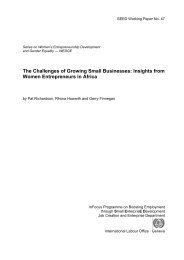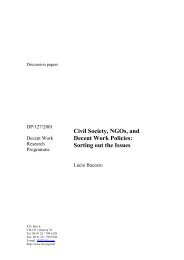manual: women workers' rights and gender equality - International ...
manual: women workers' rights and gender equality - International ...
manual: women workers' rights and gender equality - International ...
You also want an ePaper? Increase the reach of your titles
YUMPU automatically turns print PDFs into web optimized ePapers that Google loves.
• The costs for the medical treatment of the family member are very high so the woman goes<br />
again to the money lender.<br />
• Finally, draw an arrow to close the circle. This will be a never-ending story because the woman<br />
has no earnings so she can not pay back her “loan” to the money lender by any other means<br />
than by working more.<br />
Step 3<br />
• Discuss the situation using the following questions:<br />
- What do they think of the whole situation?<br />
- Is this situation fair?<br />
- Do you think the woman has another option to get money?<br />
- Can you think of ways to avoid becoming a bonded labourer?<br />
- What are other cases they can think of in which people end up like this?<br />
Step 4<br />
• Explain that this circle also applies to people who get a loan <strong>and</strong> can not pay it back because<br />
they do not have the money. When they need more money they again get a loan or even sell<br />
their children to pay back the loan. The person gets captured in the “circle of debt”.<br />
• Ask the participants to come up with situations in which they or others may need a loan<br />
• Can they think of problems for paying back this loan?<br />
• Explain the importance of a written contract when getting a loan in which all terms <strong>and</strong><br />
conditions are stated, otherwise do not get the loan.<br />
Step 5<br />
• Summarize the things done <strong>and</strong> learned during this session.<br />
Notes for the trainer<br />
After the first questions explain briefly that bonded labour usually is the result of a debt that needs<br />
to be paid back to a person in the form of unpaid labour. So the people are “bonded” to the person<br />
<strong>and</strong> often the only thing they get is food.<br />
Forced labour means any work or service that someone is forced to do under the menace of a<br />
penalty <strong>and</strong> against his or her will: People are forced to do any kind of work <strong>and</strong> often are kept in<br />
captivity. Sometimes these people are forced to do illegal activities <strong>and</strong> they get punished when<br />
caught instead of their boss. People, vulnerable to forced labour conditions, are undocumented<br />
migrant workers, hill tribes, <strong>and</strong> rural migrant workers.<br />
The Cambodian Government ratified ILO Convention 29 on Forced Labour <strong>and</strong> Convention 105 on<br />
the Abolition of Forced Labour. The aim of these Conventions is to prohibit <strong>and</strong> suppress forced or<br />
compulsory labour in all its forms.<br />
In the Labour Code 1997 article 15 states that forced or compulsory labour is absolutely forbidden<br />
<strong>and</strong> article 16 states that hiring of people for work to pay off debts is forbidden.<br />
Explain the “circle of debt” as the most common reason why people end up in bondage or forced<br />
labour. People should, if possible, avoid taking loans in this way because they are easily cheated.<br />
Discuss with the participants what risks you face if you borrow money. Whenever someone takes a<br />
loan from a person they should make sure that a contract with all terms <strong>and</strong> conditions is made,<br />
signed by both parties on every page <strong>and</strong> preferably by a (government) official as a witness. This<br />
will avoid situations like the example in this exercise.<br />
78

















